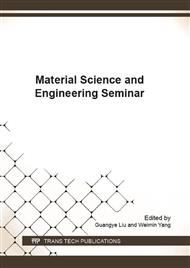[1]
Q. Li, M. Zaiser, J.R. Blackford, C. Jeffree, Y. He, V. Koutsos, Mechanical properties and microstructure of single-wall carbon nanotube/elastomeric epoxy composites with block copolymers, Materials Letters, 125 (2014) 116-119.
DOI: 10.1016/j.matlet.2014.03.096
Google Scholar
[2]
L.C. Tang, Y.J. Wan, K. Peng, Y.B. Pei, L.B. Wu, L.M. Chen, L.J. Shu, J.X. Jiang, G.Q. Lai, Fracture toughness and electrical conductivity of epoxy composites filled with carbon nanotubes and spherical particles, Composites Part A: Applied Science and Manufacturing, 45 (2013).
DOI: 10.1016/j.compositesa.2012.09.012
Google Scholar
[3]
Y.H. Chang, K.F. Lin, Physisorption of ionic salts to carbon nanotubes for enhancing dispersion and thermomechanical properties of carbon nanotube-filled epoxy resins, Composites Science and Technology, 90 (2014) 174-179.
DOI: 10.1016/j.compscitech.2013.11.011
Google Scholar
[4]
K.P. Unnikrishan, E.T. Thachil, Toughening of epoxy resins, Designed Monomers and Polymer, 9 (2006) 129-152.
DOI: 10.1163/156855506776382664
Google Scholar
[5]
J. Li, Z. Wu, C. Huang, Z. Chen, R. Huang, L. Li, Plasma functionalization for improving dispersion and interfacial bonding of multi-wall carbon nanotubes in cyanate ester/epoxy nanocomposites, Colloids and Surfaces A: Physicochemical and Engineering Aspects, 433 (2013).
DOI: 10.1016/j.colsurfa.2013.04.057
Google Scholar
[6]
M. Yourdkhani, P. Hubert, A systematic study on dispersion stability of carbon nanotube-modified epoxy resins, Carbon, 81 (2015) 251-259.
DOI: 10.1016/j.carbon.2014.09.056
Google Scholar
[7]
Q.L. Xiong, S.A. Meguid, Investigation of the Interfacial Mechanical Characteristics of Carbon Nanotube Reinforced Epoxy Composite, European Polymer Journal, DOI (2015) 1-15.
DOI: 10.1016/j.eurpolymj.2015.05.006
Google Scholar
[8]
Y. Wang, L. Gao, J. Sun, Y. Liu, S. Zheng, H. Kajiura, Y. Li, K. Noda, An integrated route for purification, cutting and dispersion of single-walled carbon nanotubes, Chemical Physics Letters, 432 (2006) 205-208.
DOI: 10.1016/j.cplett.2006.10.054
Google Scholar
[9]
O. Park, T. Jeevananda, N. Kim, S. Kim, J. Lee, Effects of surface modification on the dispersion and electrical conductivity of carbon nanotube/polyaniline composites, Scripta Materialia, 60 (2009) 551-554.
DOI: 10.1016/j.scriptamat.2008.12.005
Google Scholar
[10]
M.L. Gupta, S.A. Sydlik, J.M. Schnorr, D.J. Woo, S. Osswald, T.M. Swager, D. Raghavan, The effect of mixing methods on the dispersion of carbon nanotubes during the solvent-free processing of multiwalled carbon nanotube/epoxy composites, Journal of Polymer Science Part B: Polymer Physics, 51 (2013).
DOI: 10.1002/polb.23225
Google Scholar
[11]
J. Sha, G. Li, X. Chen, P. Xia, R. Luo, S. Yang, T. Chen, Y. Ma, L. Xie, Simultaneous ultrasonication-assisted internal mixing to prepare MWCNTs-filled epoxy composites with increased strength and thermal conductivity, Polymer Composites, DOI (2014).
DOI: 10.1002/pc.23245
Google Scholar
[12]
j. Wang, Y. Ding, K. Ma, J. Shao, Y. An, W. Yang, Dispersion of carbon nanotubes at epoxy resin with solvent-free ultrasonic, Plastic, 42 (2013) 5-9.
Google Scholar
[13]
Q. Liu, J. Tu, X. Wang, W. Yu, W. Zheng, Z. Zhao, Electrical conductivity of carbon nanotube/poly(vinylidene fluoride) composites prepared by high-speed mechanical mixing, Carbon, 50 (2012) 339-341.
DOI: 10.1016/j.carbon.2011.08.051
Google Scholar
[14]
E. Ciecierska, A. Boczkowska, K.J. Kurzydlowski, I.D. Rosca, S. Van Hoa, The effect of carbon nanotubes on epoxy matrix nanocomposites, Journal of Thermal Analysis and Calorimetry, 111 (2012) 1019-1024.
DOI: 10.1007/s10973-012-2506-0
Google Scholar
[15]
A.I. Isayev, R. Kumar, T.M. Lewis, Ultrasound assisted twin screw extrusion of polymer–nanocomposites containing carbon nanotubes, Polymer, 50 (2009) 250-260.
DOI: 10.1016/j.polymer.2008.10.052
Google Scholar
[16]
Z. Tadmor, C. Gogos, Principles of polymer processing, John Wiley & Sons, New York, (1979).
Google Scholar


